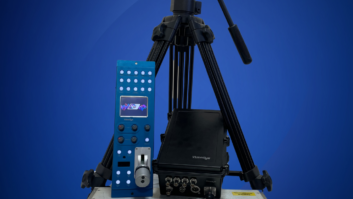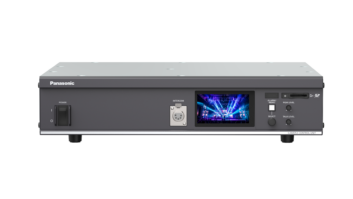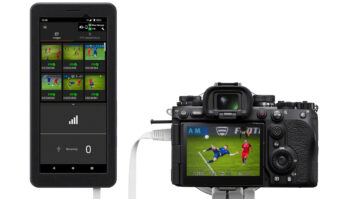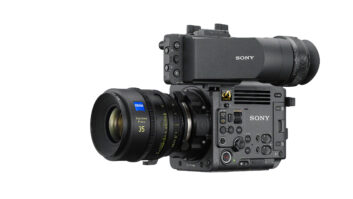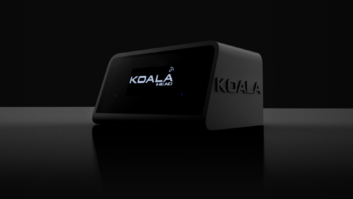
Broadcasting may start with the camera, but it has been one of the last areas to gain from the move to IT-based hardware. However, the benefits of software-upgradeable flexibility are now emerging, with free or low-cost upgrades of existing cameras a key theme at IBC this year.
Advances seen at the event included the rise of 4K, which is almost ready for mainstream production, large sensor cameras, high-speed capture, and the release of miniature cameras usable in almost any type of production.
However, the biggest crowds on the show floor were headed in the direction of ARRI’s first documentary-style shoulder-mount digital camera, the Amira, which takes the sensor and many features of its Alexa, and adds such things as in-camera colour grading and 200fps shooting.
“Everyone wants the Alexa image quality, but they said make the camera smaller, lighter and more affordable,” said Stephan Shenk, ARRI’s general manager, camera division.
It has live colour management, with 3D LUTs in the camera. “A lot of people doing documentaries don’t have the time or budget to do elaborate colour grading, but they still want the look,” said Milan Krsljanin, ARRI’s director of business development.
The Alexa influence extended to the studio, where Ikegami was showing the new HDK-97 ARRI large-sensor camera. It is “a new type of dock-cam style studio camera with an ARRI front end, using a single large super 35mm sensor. It is ideal for studio drama or music,” said Masanori Kondo, president, Ikegami Europe. The first delivery, of eight PL-mount cameras, went to MTV, which used them for its Video Music Awards.
“Although it is the same sensor as the Alexa, it is Ikegami’s digital signal processing and TV output,” added Shenk. “It’s a collaboration between Arri and Ikegami to bring the aesthetics of the motion picture to the TV studio.” It can do 1080 50p, as well as 24 and 25p, would normally be used with a fibre adaptor and will work with all of Ikegami’s existing Unicam HD accessories, so it can use the same base stations and control infrastructure.
Panasonic is also aiming for the studio drama market with its AK-HC3500A. It offers progressive shooting (1080 at 25p, 23.98p or 29.97p) with cine gamma and various other improvements to take it beyond its existing AK-HC3500.
However, it has three 2/3-inch IT CCDs rather than a single larger sensor. It boasts 60dB signal to noise, uses spatial pixel shift technology and a newly developed 16-bit A/D Digital Signal Processor (38-bit internal processing) for improved picture quality.
Hitachi has gone the MOS sensor route with its first 3MOS sensor HD camera: the affordable Z-HD6000 portable studio/EFP dockable model that outputs 1080 50/60i with 1100TV lines resolution. “This is a global release. There is a large market in the US for universities and religious use. That market doesn’t exist in Europe at a high level, but this will be an excellent entry-level product for people with small studios or OB vans,” said Paddy Roache, Hitachi director and general manager.
Sony introduced two new studio/OB camera ranges at IBC: the HSC-300R/RF and HSC-100R/RF. These are essentially upgrades of its existing HSC-300 and HXC-100 system cameras, but with new 2/3-inch Power HAD FX CCDs with an S/N ratio of 60dB. The HSC-300R/RF models are compatible with the HDLA series of large lens adapters and equipped with Neutral Density and Colour Correction dual optical servo-controlled filter wheels for outside broadcast use, while the HSC-100R/RF models are compatible with a portable lens and more suited to studio use.
Grass Valley has extended its LDX camera range with the new LDX 80 for robotic or remote use, which is claimed to offer high sensitivity with “best signal-to-noise performance”. It uses Xensium-FT 2/3-inch CMOS 1080 50/60p imagers with global shutter, and there will be three versions: LDX Compact Premiere; LDX Compact Elite; and LDX Compact Worldcam, all software upgradable.
One selling point of the LDX range has been its flexibility, “allowing instant upgrades through perpetual or weekly licensing,” said Matt Allard, Grass Valley’s market development manager.
Remote miniatures
Bradley Engineering launched three new miniature high-resolution (HD/SD up to 1080p) camera heads all with 10:1 zoom lenses at IBC. The Eyeb all-in-one design has up to 99 pre-set positions for Pan, Tilt, Zoom and Focus, for commentary use, PoVs, or reality TV. The self-contained BEHD15 is designed to give greater detail in low light, without noise, has SDI and analogue outputs, is infrared sensitive and has an IP66 option. The mini, remote ball HDC150/150SR has 32 pre-sets, is designed for smooth, quiet operation and has an infrared mode.
Its new Cam-Ball 3 miniature rotating camera can have a 30x zoom lens to go with a new high-resolution sensor with increased low light sensitivity. The 1080p PTZ camera offers 32 pre-sets in a lightweight, weatherproof carbon fibre housing, but users can remove the front seal to attach a wide angle lens.
Telemetrics’ new HDSC-1 Robotics Specialty Camera is compact, lightweight and uses a Sony 3.27-megapixel CMOS image sensor with a Canon 20x zoom lens. It provides native 1920×1080 HD-SDI video outputs as well as SD composite video outputs in NTSC and PAL.
It also has a new Remote Camera Operation System, including a touch-screen Robotic Camera Control Panel, Camera Shader Panel for single operator control of studio operations, and Enterprise Database Control Software, for enterprise level camera control using an SQL database with configurable access control.
The first operational control panel for IO Industries’ Flare 2KSDI camera has been launched by Polecam. This can control up to six cameras from one panel, including lens control (iris and focus) through the EF lens mount. The camera can output 1080 50/60p 10-bit (4:2:2 or Raw) via a single link 3G-SDI connection.
IO’s Flare camera series has been extended to include a 12-megapixel model, giving 4096×3072 pixels at up to 125fps. IO also has a new lens adaptor to allow its miniature cameras take Canon EF-mount lenses. “It’s an active adaptor, meaning we can remotely control the lens,” explained Andrew Searle, IO’s global sales manager.
“We’re really trying to focus on broadcasting,” he added, and the Polecam RCP is “really important for OB integration. We’ve had a lot of interest for live sports, especially for shooting special angles for viewing on second screen apps at home.”
IndieCam has also added new broadcast-friendly functionality for its tiny cameras with its indieUIP (Indiecam Universal Image Processor), a “powerful but still miniscule standalone Image Processor” that “gives our camera very high-quality enhanced de-bayering, detail enhancement, noise management and RGB black balance,” explained Raphael Barth, managing director.
Also new is indieGS2K RAW recording on Convergent Design’s Odyssey and Gemini 4:4:4 recorders, which can take CinemaDNG RAW footage from up to four indieGS2K cameras at once. They include rich metadata and timecode support, and recording times start at 90 minutes per camera per SSD-module.
The new sinaCAM basic miniature camera is a 2D HD version of Solectrix’s twin-head 3D sinaCAM HD remote camera. It can be controlled using a standard Sony remote control panel in an OB vehicle. The sinaCAM basic has a single 2/3-inch CCD HD sensor, runs at up to 60fps, and has a RAW output option.
GoPro has upgraded its Hero cameras. The Hero3+ models are 20% smaller and lighter with 30% better battery life than previously. They also have an improved lens, 4x faster WiFi, and a wider range of mounts. The $400 Hero3+ Black Edition also has a SuperView mode for more immersive wide-angle videos and an Auto Low Light mode that intelligently adjusts frame rate for varying lighting conditions.
The low-light performance of Ikegami’s new HDL-4500 super high sensitivity HD camera is such that “it will still give you colour pictures in star light,” according to Mark Capstick, general manager Ikegami UK. “It is a unique product. Its minimum illumination is less than 0.001 lux, in colour,” emphasised Kondo. It has three 2/3-inch CMOS sensors and can be used in normal conditions as a standard HD camera with an S/N ratio of 54dB, where it can also increase gain with lower noise.
Upgrade path
As shown with Grass Valley’s LDX range, software upgradeable cameras offer extra flexibility and can extend a camera’s life. Canon showed software upgrades for most of its cameras at IBC that brought many new features, including the ability to shoot in much lower light.
The firmware update will shift the maximum ISO setting on its EOS C500, EOS C300 and EOS C100 from ISO 20,000 to ISO 80,000, which its demonstration showed produced usable, if grainy, images.
There will also be a wide range of enhancements aimed at cinematic and drama production, notably for the 4K C500, including wider colour gamuts, a new high-speed mode at up to 120fps, and reduced fan noise during shoots.
ARRI is also upgrading its Alexa. The free Software Update Packet (SUP 9.0) offers higher speed recording,
pre-record buffers, self-healing metadata (the ability to detect an incomplete metadata file, compare it with the recorded frames and reconstruct it, to stop the camera refusing this media for further recording), and support for SanDisk’s new CFast 2.0 media. The high-end Alexa XT can now go ‘open gate’, to use all 3434×3303 pixels on the sensor.
4K + large sensor
Canon’s 4K DSLR camera, the EOS-1D C has become the first DSLR to meet the EBU Tech 3335 requirements for broadcast production. The camera is also gaining new features via a firmware update, including lens correction functions, storage of lens metadata, and improved audio with the ability to use an external audio source.
The new Blackmagic Design Production Camera 4K makes large-sensor 4K production a great deal more affordable — it costs £2589/€3089. Not surprisingly, there were thousands of pre-orders before the show.
It doesn’t do 50p, but it does support Ultra HD and 1080HD resolution capture at 23.98, 24, 25, 29.97 and 30p or 50/60i, and it has two quarter-inch jacks for audio instead of XLRs. It may not have the ergonomics and controls of a traditional camera, but its touchscreen controls are fairly simple to use, and it has useful metadata features.
There is also a Super35mm sensor, 6G-SDI output for live production, and a Thunderbolt connection. It takes EF and ZE mount lenses, records CinemaDNG Raw and Apple ProRes 422 (HQ) to its built-in SSD recorder, and comes with Blackmagic’s DaVinci Resolve colour grading software (worth €745).
Sony is also bringing 4K to lower budget productions with the new PXW-Z100, which it hopes will do for 4K what the venerable Z1 did for HD, by allowing users to begin shooting UHD even if they deliver HD, “and giving them the comfort of knowing they are investing in future-proof technology,” said Sony channel sales manager (Northern Europe), Dave Cheesman.
It will cost about €6500 and record XAVC 4K 50p/60p, 4:2:2 10-bit at 500/600Mbps, HD at up to 223Mbps from its single 1/2.33-inch 4096×2160 Exmor R sensor. It should have similar low-light performance to the PMW-100.
Panasonic has revealed its plans to introduce a 4K VariCam camcorder and ambition to occupy the middle ground for 4K, with switchers, palmcorders, field recorders and other 4K products. “There are high-end cameras and some consumer cameras, but for TV production there isn’t much choice,” said Rob Tarrant, Panasonic’s European product manager, Broadcast and Pro AV.
Its 4K/2K/HD codec will be AVC-Ultra444 and it will support 4K shooting from 24p to 100/120p using a newly developed Super35mm-size high sensitivity sensor offering wide dynamic range, extended colour space, and Log support, recording to new Ultra P2 cards with a high speed PCIe interface.
While others are tentatively moving to 4K, Red has released its latest 6K Dragon sensor for the Epic (now also available in a carbon fibre version that weighs about 500g less). The Dragon can roar along at 100fps at 6K and can be fitted as an upgrade to existing Epic and Scarlet cameras.
On Stream
For news, getting the story back fast is at least as important as picture quality, and a few cameras are now available with built-in streaming. JVC has upgraded its compact GY-HM650 camcorder to do live streaming using WiFi, 4G or 3G connections via USB while recording full HD to its SDHC/SDXC memory card, thanks to its integrated dual encoder. Material can also be uploaded in the background via FTP thanks to a Clip Trimming function, which allows users to select, copy, and dub sequences via a single button push.
“Streaming and FTP upload is a very important issue, for people to get content very fast from location to studio,” said JVC product manager, Gustav Emrich.
For French news channel BFMTV, the integrated mobile network connectivity (3G/4G/WiFi) in Panasonic’s new AJ-PX270 handheld camera was a key factor in its decision to become the first purchaser of 1/3-inch camcorder on the day it launched at IBC.
“Being able to send media while or right after shooting in different quality wasn’t possible without additional equipment. It’s an all-in-one tool that will simplify the way field newsgathering works for journalists,” said Quentin Guiné, BFMTV’s head of maintenance and operations.
The camera uses smaller microP2 cards, offers a wide range of recording formats (from Proxy to LongG 50/25 and AV-Intra class 100/50), a new design and revamped ergonomics.
By David Fox
www.arri.com
www.blackmagic-design.com
www.bradeng.com
www.canon-europe.com
www.gopro.com
www.grassvalley.com
www.hitachi-keu.com
www.i-movix.com
www.ikegami.de
www.indiecam.com
www.ioindustries.com
www.jvcpro.eu
www.livemotionconcept.de
www.panasonic-broadcast.com
www.red.com
www.solectrix.de (www.sinacam.eu)
www.pro.sony.eu
www.telemetricsinc.com
www.visionresearch.com
